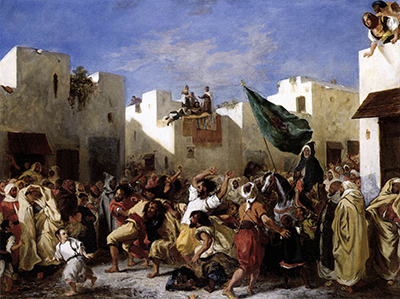Fanatics of Tangier is compositionally very similar to another painting from Eugene Delacroix, namely The Sultan of Morocco. North African culture had inspired many paintings and drawings from his career.
This piece is dated at around 1837/1838. We find a delightful recreation of the stunning architecture found in the country of Morocco, something that inspired many an artist during the Orientalist movement. Sharp angles and brightly coloured walls characterise this style which remains there today. The scene in front of us feels like a busy street, with crowds in a flurry of activity. Unlike the depiction of the Sultan of Morocco, there appears to be no real control or organisation to this crowd, hence the term Fanatics, as used by the artist to name this painting. We find the typical blue skies behind which offer a tranquility very much opposing what is found below. We see one individual raised above the crowd, and a large green flag being waved around, both of which feel like key details to this otherwise chaotic piece.
The artist initially travelled to North Africa in 1832 and so this piece would occur after the initial excitement of visiting this alternative culture would have died down. He would also have had a much better understanding of life in Morocco by now, having initially run into issues through being unaware of local customs. It is believed that the scene here was witnessed by the artist himself from the safety of his own room, peering out with curiosity but also an element of fear and confusion. What he witnessed were the Aïssaouas, a group considered by many to be a fanatical Muslim sect of that era. Those interested in the Orientalist movement should also study the more famous paintings of Gerome, such as The Carpet Merchant, The Slave Market and The Snake Charmer.
This painting can now be found in the collection of the Minneapolis Institute of Art, in the United States. Most Delacroix art remains in France, but some has found appreciative audiences elsewhere in Europe and also across in the US, as with Fanatics of Tangier. This gallery can be considered to offer a wide range of art, with also a good number of sculpture pieces from previous centuries. In terms of art related loosely to Delacroix, you may well be interested in discovering Lucretia by Rembrandt, Jonathan's Token to David by Frederic Leighton, Six Tuscan Poets by Giorgio Vasari and also The Carpet Merchant by Jean-Léon Gérôme from circa 1887. The last of those was a continuation of the role of Islamic culture within western art which became termed as Orientalism.




